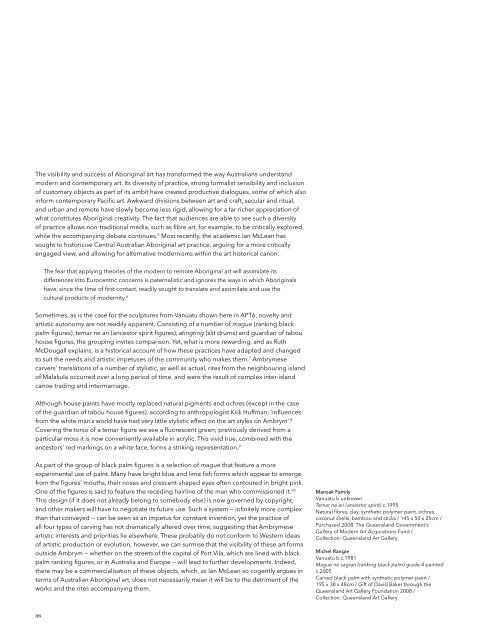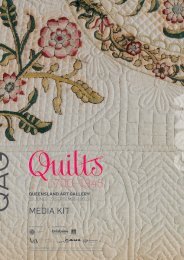Queensland Art Gallery - Queensland Government
Queensland Art Gallery - Queensland Government
Queensland Art Gallery - Queensland Government
Create successful ePaper yourself
Turn your PDF publications into a flip-book with our unique Google optimized e-Paper software.
The visibility and success of Aboriginal art has transformed the way Australians understand<br />
modern and contemporary art. Its diversity of practice, strong formalist sensibility and inclusion<br />
of customary objects as part of its ambit have created productive dialogues, some of which also<br />
inform contemporary Pacific art. Awkward divisions between art and craft, secular and ritual,<br />
and urban and remote have slowly become less rigid, allowing for a far richer appreciation of<br />
what constitutes Aboriginal creativity. The fact that audiences are able to see such a diversity<br />
of practice allows non-traditional media, such as fibre art, for example, to be critically explored,<br />
while the accompanying debate continues. 5 Most recently, the academic Ian McLean has<br />
sought to historicise Central Australian Aboriginal art practice, arguing for a more critically<br />
engaged view, and allowing for alternative modernisms within the art historical canon:<br />
The fear that applying theories of the modern to remote Aboriginal art will assimilate its<br />
differences into Eurocentric concerns is paternalistic and ignores the ways in which Aboriginals<br />
have, since the time of first contact, readily sought to translate and assimilate and use the<br />
cultural products of modernity. 6<br />
Sometimes, as is the case for the sculptures from Vanuatu shown here in APT6, novelty and<br />
artistic autonomy are not readily apparent. Consisting of a number of mague (ranking black<br />
palm figures), temar ne ari (ancestor spirit figures), atingting (slit drums) and guardian of tabou<br />
house figures, the grouping invites comparison. Yet, what is more rewarding, and as Ruth<br />
McDougall explains, is a historical account of how these practices have adapted and changed<br />
to suit the needs and artistic impetuses of the community who makes them. 7 Ambrymese<br />
carvers’ translations of a number of stylistic, as well as actual, rites from the neighbouring island<br />
of Malakula occurred over a long period of time, and were the result of complex inter-island<br />
canoe trading and intermarriage.<br />
Although house paints have mostly replaced natural pigments and ochres (except in the case<br />
of the guardian of tabou house figures), according to anthropologist Kirk Huffman: ‘influences<br />
from the white man’s world have had very little stylistic effect on the art styles on Ambrym’. 8<br />
Covering the torso of a temar figure we see a fluorescent green; previously derived from a<br />
particular moss it is now conveniently available in acrylic. This vivid hue, combined with the<br />
ancestors’ red markings on a white face, forms a striking representation. 9<br />
As part of the group of black palm figures is a selection of mague that feature a more<br />
experimental use of paint. Many have bright blue and lime fish forms which appear to emerge<br />
from the figures’ mouths, their noses and crescent-shaped eyes often contoured in bright pink.<br />
One of the figures is said to feature the receding hairline of the man who commissioned it. 10<br />
This design (if it does not already belong to somebody else) is now governed by copyright,<br />
and other makers will have to negotiate its future use. Such a system — infinitely more complex<br />
than that conveyed — can be seen as an impetus for constant invention, yet the practice of<br />
all four types of carving has not dramatically altered over time, suggesting that Ambrymese<br />
artistic interests and priorities lie elsewhere. These probably do not conform to Western ideas<br />
of artistic production or evolution; however, we can surmise that the visibility of these art forms<br />
outside Ambrym — whether on the streets of the capital of Port Vila, which are lined with black<br />
palm ranking figures, or in Australia and Europe — will lead to further developments. Indeed,<br />
there may be a commercialisation of these objects, which, as Ian McLean so cogently argues in<br />
terms of Australian Aboriginal art, does not necessarily mean it will be to the detriment of the<br />
works and the rites accompanying them.<br />
Mansak Family<br />
Vanuatu b.unknown<br />
Temar ne ari (ancestor spirit) c.1995<br />
Natural fibres, clay, synthetic polymer paint, ochres,<br />
coconut shells, bamboo and sticks / 145 x 50 x 25cm /<br />
Purchased 2008. The <strong>Queensland</strong> <strong>Government</strong>’s<br />
<strong>Gallery</strong> of Modern <strong>Art</strong> Acquisitions Fund /<br />
Collection: <strong>Queensland</strong> <strong>Art</strong> <strong>Gallery</strong><br />
Michel Rangie<br />
Vanuatu b.c.1981<br />
Mague ne sagran (ranking black palm) grade 4 painted<br />
c.2005<br />
Carved black palm with synthetic polymer paint /<br />
195 x 38 x 48cm / Gift of David Baker through the<br />
<strong>Queensland</strong> <strong>Art</strong> <strong>Gallery</strong> Foundation 2008 /<br />
Collection: <strong>Queensland</strong> <strong>Art</strong> <strong>Gallery</strong><br />
36 37
















